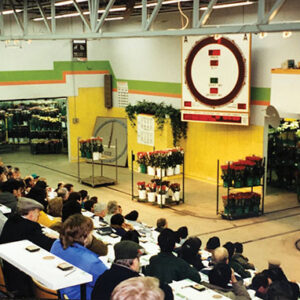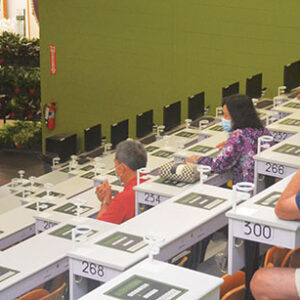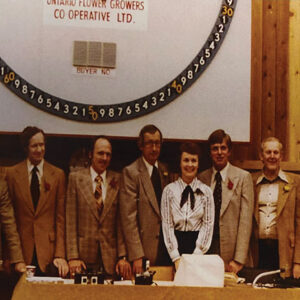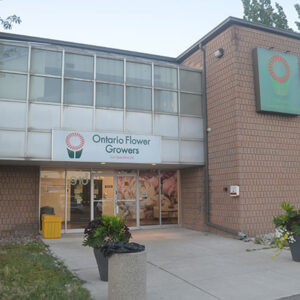
Features
Celebrating 50 years of flowers
Ontario Flower Growers Co-operative Ltd. marks its 50th anniversary this October. It has changed, and survived, says Jack VanderMaas, CEO, Mississauga.
September 6, 2022 By John Dietz
 CEO Jack VanderMaas says OFG’s sales now include auction gallery clock sales, online flower sales and OFG’s new wholesale company, OFG Marketplace. Photo: Andrew Snook.
CEO Jack VanderMaas says OFG’s sales now include auction gallery clock sales, online flower sales and OFG’s new wholesale company, OFG Marketplace. Photo: Andrew Snook. Ontario Flower Growers Co-Operative (OFG) started with a Dutch clock auction selling cut flowers and potted plants 50 years ago, and today it’s run by a Dutchman.
“OFG is so much more than just a flower auction today,” says CEO Jack VanderMaas.
OFG is now more diverse, sales include regular auction gallery clock sales, online flower sales and OFG’s new wholesale company, OFG Marketplace.
Ontario Flower Growers Co-operative (OFG) was established when 63 southern Ontario growers committed, as shareholders, to implement a centralized, one-source, cost-effective process to market and sell their products to florists serving the Greater Toronto Area (GTA) and surrounding areas.
Growers needed an efficient, effective way to sell fresh-cut flowers and potted plants. With many growers having Dutch roots, “They took the concept of a flower auction from back in Holland to start their own flower auction here,” VanderMaas says.
Growers in Holland had established success in marketing flowers and potted plants by selling from a central point, using the Dutch clock system and an auctioneer. The Dutch clock auction method runs in reverse to a regular auction, the auction opens at an asking price above market value and gradually reduces the bid price until it sells. The process repeats until the last lot is sold. Growers can protect their investment with what is called a buyback bid price.
VanderMaas was a youth in Zeeland, Holland in 1972. After graduating as a floral designer, he worked as a floral designer in Heinkenszand, Zeeland and then immigrated to St. Catharines, Ontario in 1988. He worked for wholesalers for 13 years, delivering and selling flowers to florists. In 2001, he started his own wholesale company with his own “bucket” truck.
In December 2017, VanderMaas was appointed the new CEO of Ontario Flower Growers.
OFG shareholders had selected Mississauga as the centre of operations, close to the international airport, major transport links and the GTA.
OFG first opened on Dorman Drive in Malton with Mildred O’Brien as general manager. In 1975, it moved to larger premises on Ambler Drive in Mississauga. With the need for more space in the fall of 1985, OFG moved to the current location on Mid-Way Boulevard in Mississauga.
OFG has established itself as the “hub” of the flower industry. A number of floral wholesalers have moved to this area. The 172,000-square-foot warehouse is the size of three football fields. Nearly 40,000 square feet is a heated, all-weather loading facility.
Greenhouses and seasonal fields, mostly in southern Ontario, supply the OFG. Mornings, growers are cutting their fresh flowers and preparing potted plants. Growers drive to the OFG warehouse and deliver their products in the afternoon or evening. As product arrives, OFG workers inventory each shipment with grower sheets to describe the merchandise, its species, grade, and quantity.
As well, fresh flowers also arrive from the airport, imported from western Europe, Africa, Central or South America.
The OFG has fewer shareholders today, only 37. They elect directors and share operating costs. VanderMaas says, “Some (shareholders) retired. We lost some to cannabis. Plans of growers simply didn’t fit the co-op model.”
Only shareholders and guest growers are permitted to sell at OFG. “A shareholder can bring in whatever they grow but OFG supply management can say ‘not now’ to a guest growers’ product. Growers, shareholders and guest growers pay a commission but guest growers don’t share in the profit when there are payouts.”
About 500 two-metre-tall steel carts are available for organizing the incoming shipments and later dispersing the outgoing products. When it’s labelled and loaded, each cart is photographed. The photo and data about the contents of the cart are posted shortly before the auction.
Methods to sell grower fresh product include OFG regular auction gallery, auction remote and Pre-auction Purchasing (PAP)
The big auction centre has 53 employees working in three shifts today.
Changed by Covid
The CEO attributes most of the changes to COVID-19 and to increased operating efficiency. The sorting and dispersing process is much faster and easier today, requiring less labour than it did before.
Ontario declared a state of emergency due to COVID-19 on March 17, 2020. Social distancing, protective face masks and other measures were mandated for the next 27 months.
“That affected a lot of things. At first, we wondered how to handle it. There were no auctions for about eight months,” says the CEO. “We changed. We sell differently today and it turned out to be a very successful change.”
For decades, flower growers and buyers had rubbed shoulders daily in the 308-seat central auction gallery. Monday to Friday sales began at 6 a.m. sharp. Depending on volume, auctions lasted one to three hours.
From the left, carts loaded with cut flowers rolled in front of the buyers sitting in the gallery. Other carts rolled in from the right, loaded with potted plants. A drag chain under the floor helped staff tow in the carts. Buyers placed electronic bids from keypads mounted to the lecture-theatre desks. Each time, one of the giant overhead clocks stopped to record the bid and price. The buyer could choose to take a single bucket of flowers, a tray of plants, or as many as the cart carried.
The downward price roll resumed and continued until that collection of flowers, perhaps 50 buckets of matching roses or tulips on a cart, was sold out. Then the cart rolled away to the other side of the building for dispersal to the waiting carts of buyers.
Like a brick, Covid hit that smoothly running system, and petals flew everywhere for a while.
“Now it’s a bit different here,” Jack says. “We slowly went back into the auction format in September 2020, with two auctions a week, Tuesdays and Thursdays, because people were asking for it. There’s still a need for a physical auction, and it’s going fairly well. I would like to bring it up to three days a week, but I don’t think it’s time for that yet.”
The second marketing approach, Shop the Clock (STC) began pre-Covid. STC sales were one day a week. As Covid restrictions on masking and distancing developed, buyers abandoned their cherished gallery seats in favor of online purchases from home or the office. Today, online sales, four days a week, dominate the OFG sales volume. Grower product is listed on OFG’s STC website; customers make purchases online. Product is delivered to OFG and made ready for customer pick up.
VanderMaas says, “At first it was a very cumbersome switch, but we made it work. We even got new customers because of it. The younger generation knows how to buy online; they are not afraid of it. The older generation wants to come in, to see the product, to press the button at the auction, to take the chance or play the market. But, when we suddenly didn’t have a live auction, they didn’t have a choice. They still needed the product and they gradually started to buy their flowers and potted plants online, too.”
He adds, “Online business has taken off. It’s definitely a game-changer. A lot of buyers like that option and, funny enough, we have more buyers today. They don’t have to get up at 4 a.m., drive here, and sit in the gallery to buy flowers. They can buy before breakfast and pick up the order whenever they want. Everything they purchased is on one or two carts, identified, and waiting to be picked up.”
New ways to sell
In 2018, the OFG implemented a direct wholesale business, OFG Marketplace.
“We needed to build a cooler for this, so we carved out an area of the building for potted plants and a cut-flower cooler. Buyers can go into The Marketplace, our wholesale division, and buy single bunches or single plants after the auction. You can buy by the bunch as well as by the pail or bucket. That helped us a lot, too, during the COVID pandemic,” he says. “We’ve been fairly successful with that. Sales there are still growing.”
Today’s CEO for Ontario Flower Growers Cooperative Ltd concludes, “It’s nice to know that, after 50 years, we are still around and still do almost the same thing we did 50 years ago, but much more efficiently. That’s a good thing, for everybody.”
Print this page



